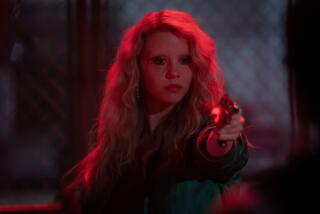MOVIE REVIEWS : ‘MAXIE’: A WOULD-BE STAR OF THE ‘20S IS REBORN
- Share via
“Maxie” (citywide) is a flaming flapper whose spirit just won’t stay locked behind those pearly gates.
Killed in a car crash on her way to a screen test with D. W. Griffith, Maxie was not to know whether she could have been a star. But now, nearly 60 years after her death, she has another chance to find out.
It happens this way: A nice young couple, Jan (Glenn Close) and Nick (Mandy Patinkin), are fixing up a San Francisco Victorian they’ve rented from Maxie’s old song-and-dance partner (Ruth Gordon), who lives in its attic. Peeling away layers of wallpaper, Patinkin uncovers a message scrawled in fire-engine-red lipstick: “Maxie Malone Lived Here/March 3, 1927/Read It and Weep!”
Learning who Maxie was from Gordon, Patinkin rents the one movie in which Maxie had a bit part. No sooner does he decide that Maxie really had it than the bespangled lady herself materializes--but only faintly. Short on ectoplasm, her spirit decides to invade Jan’s body at will.
No wonder Glenn Close took on this dual role. What highly praised serious actress wouldn’t be tempted by such a gaudy change of pace--and by Ann Roth’s witty costumes for Maxie. One minute Close is the conservative, overly dedicated secretary to the Bishop of San Francisco (the very droll Barnard Hughes), the next she’s the hotcha jazz baby shocking a sedate gathering of Patinkin’s fellow librarians (including his man-eating new boss Valerie Curtin, amusingly hateful). What’s more, the uninhibited Maxie, Nick must admit, provides him with certain thrills that Jan would be too ashamed even to contemplate.
Although the fun the well-matched Close and Patinkin are having is contagious, “Maxie,” for all its moments both hilarious and poignant, is not quite the movie it might have been. The problem is with Paul Aaron’s direction, not with Patricia Resnick’s script, which she adapted from Jack Finney’s “Marion’s Wall.”
Aaron is a capable director of actors but not much of a stylist. His approach is too head-on, and the blunt quality he brings to the film is further emphasized by cinematographer Fred Schuler’s unrelenting adherence to the bright-is-for-comedy axiom in lighting. (Too bad the film as a whole doesn’t have the elegance of Georges Delerue’s score) “Maxie” has the material and stars with the intelligence, though perhaps not the old-time glamour, for ‘30s-style screwball comedy, but it lacks that sophisticated, throwaway ease essential to bringing it off with complete success. One of the pleasures of “Maxie” is that Ruth Gordon is terrific in what proved to be her final role. She’s perfectly cast as the pixieish landlady, and she’s wonderful when she goes through her old dancing routine with Maxie. Even better is the moment when she and Maxie recognize each other over the decades. “Maxie” (rated PG for some adult situations) provides a fitting finish to Gordon’s astonishing 70-year career.
‘MAXIE’ An Orion release of an Aurora presentation. Executive producers Rich Irvine, James L. Stewart. Producer Carter De Haven. Director Paul Aaron. Screenplay Patricia Resnick, based on “Marion’s Wall” by Jack Finney. Camera Fred Schuler. Music Georges Delerue. Costumes Ann Roth. Choreographer Matthew Diamond. Ghost visual effects Bill Taylor. Film editor Lynzee Klingman. With Glenn Close, Mandy Patinkin, Ruth Gordon, Barnard Hughes, Valerie Curtin, Googy Gress, Michael Ensign, Michael Laskin, Lou Cutell, Nelson Welch, Leeza Gibbons, Evan Gibbons, Even White, Harry Wong.
Running time: 1 hour, 37 minutes.
MPAA-rated: PG (parental guidance suggested).
More to Read
Only good movies
Get the Indie Focus newsletter, Mark Olsen's weekly guide to the world of cinema.
You may occasionally receive promotional content from the Los Angeles Times.










